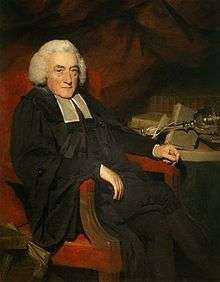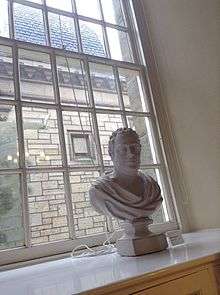William Robertson (historian)
| William Robertson FRSE FSA Scot | |
|---|---|
 William Robertson (1721-93) | |
| Born |
19 September 1721 Borthwick, Midlothian, |
| Died |
11 June 1793 (aged 71) Edinburgh |
| Nationality | Scottish |
| Education | Dalkeith Grammar School |
| Alma mater | University of Edinburgh |
| Known for |
Principal of the University of Edinburgh; Moderator of the General Assembly of the Church of Scotland; Historiographer Royal |

Rev William Robertson FRSE FSA Scot DD (19 September 1721 – 11 June 1793) was a Scottish historian, minister in the Church of Scotland, and Principal of the University of Edinburgh. "The thirty years during which [he] presided over the University perhaps represent the highest point in its history."[1] He made significant contributions to the writing of Scottish history and the history of Spain and Spanish America.[2]
He was Chaplain of Stirling Castle and one of the King's Chaplains in Scotland.
Life
Robertson was born at the manse of Borthwick, Midlothian, and educated at Borthwick Parish School and Dalkeith Grammar School. He was the son of Rev William Robertson and his wife Eleanor Pitcairn. The family moved to Edinburgh when his father became appointed minister of Old Greyfriars Kirk.
He studied Divinity at the University of Edinburgh (1733–41), and was licensed to preach in 1741. He was granted a Doctor of Divinity in 1759.[3] He became minister at Gladsmuir (East Lothian) in 1743 and in 1759 at Lady Yester's Kirk and Greyfriars Kirk in Edinburgh. A staunch Presbyterian and Whig, he volunteered to defend the city against the Jacobites led by Prince Charles Edward Stuart in 1745.
In 1754 he was an original member of the Edinburgh Select Society.[4]
Robertson became royal chaplain to George III (1761), principal of the University of Edinburgh (1762), Moderator of the General Assembly of the Church of Scotland in 1763, and Historiographer Royal in 1764, reviving a role within the Royal household in Scotland that had been in abeyance from 1709 until 1763. He was also a member of The Poker Club.[5]
One of his most notable works is his History of Scotland 1542–1603, begun in 1753 and first published in 1759.[6] Robertson also contributed to the history of Spain and Spanish America in his History of America (1777), "the first sustained attempt to describe the discovery, conquest and settlement of Spanish America since Herrera's Décadas[7] and his biography of Charles V. In that work he had "provided a masterly survey of the progress of European society, in which he traced the erosion of the 'feudal system' caused by the rise of free towns, the revival of learning and Roman law, and by the emergence of royal authority and the balace of power between states. It was the development of commerce, assisted by law and private property, which was held to be chiefly responsible for the advance in civilisation."[8]
He was a significant figure in the Scottish Enlightenment and also of the moderates in the Church of Scotland.[9]
In 1783 he was a founding member of the Royal Society of Edinburgh.
He died at Grange House in south Edinburgh (the huge now-demolished mansion which gave its name to the Grange district in Edinburgh) on 11 June 1793.[10] Robertson is buried at Greyfriars Kirkyard, Edinburgh. The grave is within a very large stone mausoleum. second only to William Adam's mausoleum immediately to the south. Both stand to the south-west of the church, near the entrance to the Covenanters Prison.

Legacy
He gives his name to the William Robertson Building of the Old Medical School buildings at the University of Edinburgh on Teviot Place, home to the School of History, Classics and Archaeology.
Family
Robertson married Mary Nisbet in 1751. They had three sons:
- Hon William Robertson, Lord Robertson FRSE, Senator of the College of Justice (1753–1835)
- General James Robertson (died 1845)
- Lt Col David Robertson McDonald FRSE (1761–1845)
All three sons are buried in Greyfriars Kirkyard in individual plots behind their father's mausoleum.
One of his daughters married the author Patrick Brydone FRSE and another married John Russell co-founder of the Royal Society of Edinburgh.
Publications
- The Situation of the World at the Time of Christ's Appearance (sermon) (1755)
- The History of Scotland 1542-1603 (1759) (3 vols.)
- History of the Reign of the Emperor Charles V (1769) (4 vols.)
- The History of America (1777, 1796) (3 vols.)
- An Historical Disquisition Concerning the Knowledge Which the Ancients Had of India (1791)
References
- ↑ Horn, D. B., A Short History of the University of Edinburgh: 1556–1889, 1967, p.76
- ↑ R.A. Humphreys, William Robertson and his History of America. London 1954.
- ↑ Waterston, Charles D; Macmillan Shearer, A (July 2006). Former Fellows of the Royal Society of Edinburgh 1783-2002: Biographical Index (PDF). II. Edinburgh: The Royal Society of Edinburgh. ISBN 978-0-902198-84-5. Retrieved 29 September 2010.
- ↑ https://www.royalsoced.org.uk/cms/files/fellows/biographical_index/fells_indexp2.pdf
- ↑ "The Poker Club | James Boswell .info". jamesboswell.info. Retrieved 16 August 2016.
- ↑ David J. Womersley, "The historical writings of William Robertson." Journal of the History of Ideas (1986): 497-506. in JSTOR
- ↑ David Brading, The First America: The Spanish Monarchy, Creole Patriots, and the Liberal State 1492–1867. New York: Cambridge University Press 1991, p. 432.
- ↑ Brading, The First America, p. 433.
- ↑ Shefr, R. B., Church and Society in the Scottish Enlightenment: The Moderate Literati of Edinburgh, Princeton, 1985.
- ↑ https://www.royalsoced.org.uk/cms/files/fellows/biographical_index/fells_indexp2.pdf
Further reading
- Brown, S. J. (ed.), William Robertson and the Expansion of Empire, Cambridge, 1997
External links
| Wikiquote has quotations related to: William Robertson (historian) |
- William Robertson at James Boswell - a Guide
| Preceded by John Gowdie |
Principal, University of Edinburgh 1762–1793 |
Succeeded by George Husband Baird |